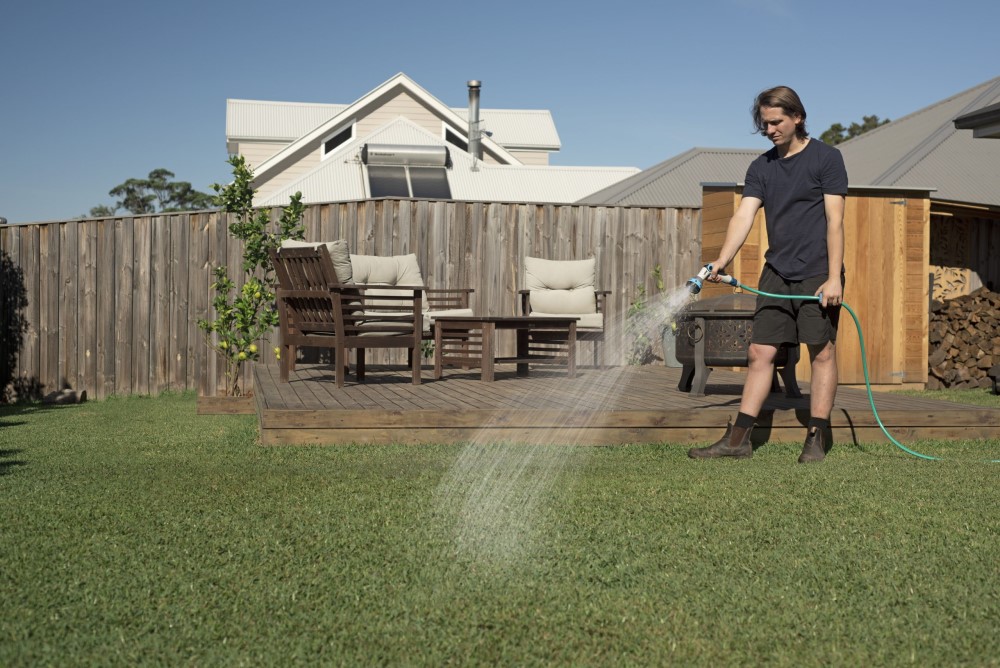Signs You Have an Overwatered Lawn and How to Fix It
How To Fix An Overwatered Lawn
Overwatering your lawn can be just as detrimental as not watering it enough. In some ways, it can become more harmful to your lawn.
A healthy lawn needs sunlight and water to thrive. But, like all good things, it needs these things in balance.
Here’s how to recognise the signs of an overwatered lawn, how to fix it, and tips to avoid overwatering in the future.
What does grass look like if it’s overwatered?
When something isn’t right, your lawn will try to tell you. If you notice any of the below signs of damage or stress, it might be due to an overwatered lawn.
Yellowing or discoloured grass
If your grass is paling or turning yellow, this is typically because the roots are deprived of oxygen.
When a lawn is overwatered, excessive water can block oxygen from reaching the root system and cause discolouration.
Mushy soil
If your lawn feels spongy or soggy when you walk across it, this is an early sign that your lawn is being overwatered.
This feeling is due to water not being fully absorbed or draining away.
Excessive fungal growth
Excess water in your lawn typically leads to fungal growth or lawn disease.
Developing in damp environments, you may notice the appearance of mushrooms, powdery mildew, or brown patches.
Rapid weed growth
As well as causing difficult conditions for your lawn, overwatering grass can also create the ideal conditions for some weeds to grow. Weeds such as crabgrass and nutsedge thrive in overwatered grass.
Runoff and puddles
Water that the wet soil cannot absorb leads to runoff or puddling in your lawn.
Thatch buildup
Thatch is a layer of dead grass, roots, and other organic material that accumulates between the soil and the green grass blades.
Overwatering can lead to excessive thatch buildup because the constant moisture creates an environment where organic matter decomposes slowly.
This thick layer of thatch can suffocate your grass by preventing air, water, and nutrients from reaching the soil.
Pest infestation
Overwatering your lawn can create the perfect breeding ground for pests. Wet soil and lush, moist grass provide an ideal environment for insects such as grubs.
These pests thrive in damp conditions and can cause significant damage to your lawn by feeding on grass roots and blades.
Patchy lawn
Finally, an indicator of overwatering is the presence of bare patches in your lawn. Excessive moisture can lead to soil compaction and root rot, which weakens the grass and makes it more susceptible to damage.
As a result, you may notice areas where the grass has thinned out or disappeared altogether, leaving unsightly bare spots.
How to fix an overwatered lawn
1. Reduce watering
Immediately cut back on watering. Allow your lawn to dry out by adjusting your watering schedule to ensure the soil is just moist, rather than saturated.
2. Adjust your sprinkler system
If you have an automatic sprinkler or an irrigation system, you should adjust the settings to reduce how frequently you watering your lawn.
While a sprinkler or irrigation system is incredibly useful for watering your lawn at the best time of day, they tend to contribute to overwatering when there has been enough natural rainfall for your lawn.
3. Aerate the lawn
Aeration helps improve soil drainage and allows oxygen to reach the grassroots. Use a garden fork or aerating sandals to help relieve compaction and promote a healthy root system.
4. Dethatch
To restore an overwatered lawn, you should remove excess thatch which could be holding moisture and prevent air from reaching the soil.
5. Treat fungal issues
Apply fungicides if necessary to control fungal diseases exacerbated by overwatering. Ensure you follow the product instructions carefully.
6. Improve soil health
Consider applying a balanced fertiliser to replenish nutrients washed away by excessive watering.
Opt for slow-release fertilisers to give your lawn time to absorb nutrients without being overloaded.
How to Prevent a Soggy Lawn in Australia
As well as regular lawn maintenance, you can prevent overwatering your established lawn a couple of ways.
Adjusting watering practices
One of the simplest yet most effective ways to prevent overwatering is to adjust your watering practices.
Using a moisture meter can help you accurately assess the soil moisture levels and determine when your lawn actually needs water.
This tool ensures you only water your lawn when necessary, preventing excessive moisture buildup.
Additionally, consider watering your lawn in the early morning to minimise evaporation as well as risk of disease.
Improving Drainage
If your lawn has poor drainage, water can quickly accumulate and lead to soggy conditions.
You might need to install a drainage system, such as French drains or a dry well, to redirect excess water away from your lawn.
Another effective method is to amend your soil with organic matter like compost.
This not only enhances the soil structure but also improves its drainage capacity, allowing water to flow through more easily.
Selecting the right grass
Choosing the right grass variety for your local climate and soil conditions is essential in preventing a soggy lawn.
Some grass types are more tolerant of excessive moisture and can thrive even during periods of heavy rainfall.
Grass varieties like Eureka Kikuyu, Sir Walter Buffalo, and Sir Grange Zoysia are well-suited to various climates and can better withstand wet conditions.
Selecting a grass type that matches your environment can significantly reduce the risk of overwatering-related issues.
Overwatering FAQs
Is overwatering bad for a lawn?
Yes, overwatering can be very harmful to your lawn. It can drown the grassroots, leading to a shallow root system and increased vulnerability to diseases and pests.
The excessive moisture can also lead to soil compaction and reduce the lawn’s overall health and resilience.
Can grass recover from too much water?
Grass can recover from overwatering if the issue is addressed promptly. Reduce watering, improve soil aeration and drainage, and treat any resulting diseases or pest infestations. Recovery may take some time, but with proper care, you can repair any lawn harm.
How long do you water newly laid grass?
Newly laid grass requires more frequent watering to establish roots, typically watering lightly once or twice a day for the first two weeks.
Gradually reduce the frequency to encourage deeper root growth, eventually transitioning to a regular watering schedule of about 1 inch of water per week, applied deeply and infrequently.
Read more:
read more!
recent posts
Poolside Turf: Choosing and Maintaining Grass Around Pools
There’s nothing quite like stepping out of a swimming pool onto soft, lush grass. But when it comes to finding the best grass for around a pool, not all lawns are created equal. Chlorine pools, heavy foot traffic, and the unforgiving Australian sun can take a toll on...
Keeping Your Lawn Green and Healthy During the Summer Heat
Discover the best grass options for your lawn with our complete guide. Make informed choices for a lush, healthy yard. Read more to find your ideal grass!
Summer Lawn Weeds: Prevention and Management
Discover the best grass options for your lawn with our complete guide. Make informed choices for a lush, healthy yard. Read more to find your ideal grass!

Our Turf
TifTuf Bermuda
Buy Turf Online © 2019 All Rights Reserved. | Proudly Designed and Developed by Sydney ICT




